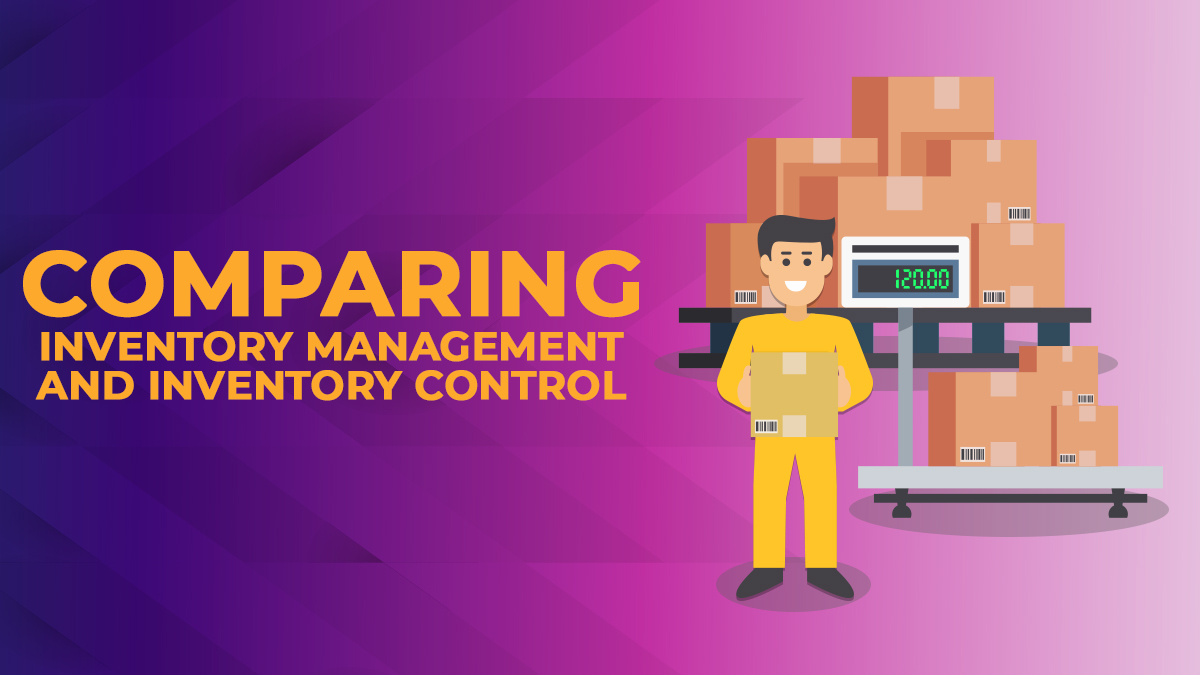
Some people may think that inventory management and inventory control mean the same thing. However, the truth is that they do not. Let us discuss the similarities and differences between inventory management and inventory control in this article.

Inventory Management and Inventory Control
Generally, when we say inventory management, it deals with ordering, storing, and managing stock and forecasting inventory. On the other hand, when we talk about inventory control (or stock control), it concerns handling the stock that you have on hand. Let us see more on how these two similar concepts compare below:
Inventory Management
Inventory management deals with the entire process of ordering and managing stocks on hand (raw materials or finished goods) and forecasting demand based on previous sales data. Thus, it follows broader market trends over more extended periods. With inventory management, you can determine how much to purchase and when to purchase to ensure that you only order what you need for a particular period or season.
As such, in inventory management, you need to monitor the lifecycle of raw and finished goods. This particular lifecycle spans from the time you ordered a product from your suppliers to the time you deliver the goods to your customers. As such, with inventory management, you can help ensure that there is enough stock on hand to satisfy your customers’ needs, thereby removing the need to spend excess in buying more than what your business needs.
Here are some of the common features of inventory management:
‣ End-to-end stock management
‣ Demand forecasting through past sales data
‣ Helps determine when to restock
‣ Inventory checking, tracking, and auditing
Inventory Control
As one of the aspects that form part of the entire inventory management process, inventory control entails the day-to-day management of stock in your warehouse. Some of the activities that fall under inventory control include receiving stocks, storing stocks, transferring stocks, tracking stocks, fulfilling stock orders, and facilitating stock returns.
Moreover, when dealing with inventory control, you also need to get acquainted with stock rotation. Knowing your stock rotation ensures that you know the flow of your stock, thereby giving you control over the goods that you need to satisfy your clients' orders when they need them.
Here are some of the common inventory control methods that you can adopt for your overall inventory management:
FIFO
First In, First Out (FIFO) means that you use your oldest stock first to satisfy a customer’s order. The FIFO method works best for businesses that sell perishable goods or products with limited shelf life, including meat, fruits, vegetables, and flowers. Using this method helps them reduce loss.
LIFO
Last In, First Out (LIFO) means that you use the most recent stock received to fulfill a customer's order. The LIFO method is most useful for businesses that sell products that experience inflation every year. For instance, convenience stores, supermarkets, and pharmacies use this method because the price of most of their products rise yearly.
FEFO
First Expired, First Out (FEFO) means that you use the stock with the closest expiration date to satisfy a customer's demand. Businesses that sell products with a limited shelf life such as consumer goods or perishable goods may also use the FEFO method. For this reason, FEFO is used mostly in chemical and pharmaceutical industries.
Check out some of the basic features of inventory control:
‣ organizing stock and tracking its specific location within a warehouse
‣ keeping stocks in good condition and using them before they expire, eliminating spoilage
‣ placing popular items near packing areas for efficient order fulfillment
‣ reduces stockouts and backorders
Efficient Inventory Management Requires Proper Inventory Control
It would be best if you had good stock control to manage your inventory efficiently. So, make sure that you know what stock you have in your warehouse and their respective conditions. Then, ensure that you strategically placed them in your warehouse for improved storage and retrieval whenever a customer orders a product.
After that, you can forecast based on previous data and seasonality to help better manage inventory. With that, you can adjust stock types, including their respective quantities and order cycles. In doing so, you can effectively meet the changing demands of your customers while taking into consideration your suppliers, manufacturers, and business partners, if any.
Inventory Management and Inventory Control Systems
With technological advancement, software and application developers could design and build business solutions that help overcome inventory management challenges. Let’s see how an inventory management system and inventory control system may help you:
An inventory management system helps you:
‣ manage your stocks, especially if you store and sell through multiple warehouses and various selling platforms or channels (online, physical stores, retailers, etc.)
‣ trace inventory according to their size, color, serial number, and the like
‣ gain information about the order and fulfillment process
‣ perform physical counts and cycle inventory
‣ generate reports on inventory trends (based on collected data) to help you predict product demand and order the right amount of stock
On the other hand, an inventory control system helps you:
‣ manage and facilitate daily and more particular stock and warehouse activities
‣ determine the number of stocks on hand, specific details about your products, and their respective storage locations in your warehouse
‣ track stock transfers and the respective movement of orders and returns
‣ gain real-time updates on stocks, so you can know when you have expiring, understocked, or overstocked items, which then helps maintain proper inventory

Inventory Management and Inventory Control for Efficient Stock Handling
All in all, both inventory management and inventory control are essential in efficiently handling your stocks. So, we hope we clarified certain confusions regarding these two interrelated and often interchanged concepts in managing inventory.
Try out an online inventory system to help you manage your stocks more efficiently! If you have any more questions about inventory management and inventory control, drop them in the comments section below!
